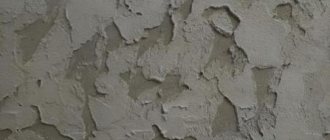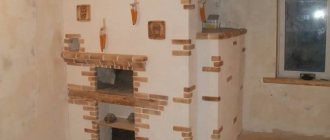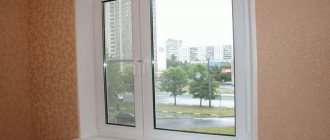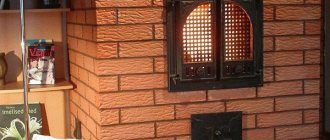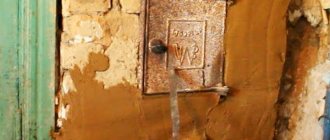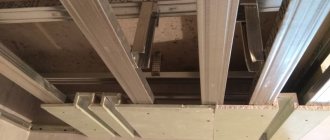Repairing cracks in plaster and why it cracks
Cracks that appear on the plaster can upset anyone. Some make every effort to avoid them, others absolutely love decorative plaster with the effect of cracks, but an unexpected crack always causes irritation. Especially if you remember how much effort was required to apply the plaster.
Every professional knows that cracks are an obligatory phenomenon that is almost impossible to avoid.
A little-known fact: modern engineers can predict with 100% accuracy where cracks will appear and know why plaster cracks when it dries. How do they know this? The answer is simple, before work they are required to plan where cracks are allowed to appear.
It is currently impossible to avoid the occurrence of this phenomenon, but it is undoubtedly possible to control and eliminate them.
Causes of cracks in the walls of a house
If the supporting soils do not evenly accept the load, the foundation strip will deform more strongly than the walls of the building can withstand.
As a result, it can be assumed that cracks in the walls of buildings are formed due to design errors, incorrect construction of the building, as well as errors made during the construction of the building.
One of the reasons for cracks in walls is that the layer of soil that is located under the base is not homogeneous. Those areas that have a high density have more pressure on them and therefore the building can only rest on a few points. As a result, it deforms under its own weight. But there is one peculiarity and it is that over time the density of plots can change significantly due to weather conditions. Also, due to the fact that the soil freezes, there may be heaving of the soil, and when wet, the soil becomes too soft.
If you find that there is a crack in the wall of the house, then you need to observe their development for some time, and you need to monitor the temperature change, as well as the presence of precipitation. In order to have some idea of the nature of the appearance of cracks, you need to keep a special log during the current year.
Why they appear inside a brick house: where to go
The most common cause of cracks in a brick house is its shrinkage.
In addition, the builders, who made mistakes in construction technology, did not give the foundation time to stand during one winter period. As a rule, it is for these reasons that splits occur in the wall, which are important to eliminate in a timely manner.
When flaws appear, they need to be “treated.”
And for this you need to decide: where to turn for help?
Since the management company may refuse to solve the problem, you need to act independently. The design and construction organization will assess the entire current situation and advise where to turn.
Need advice: how to remove cracks on a wall
The walls were plastered, puttied, and then whitewashed. After 3 months, small cracks appeared, 1-2mm. Sand-cement plaster.
Tell me how to get rid of them and why they appeared.
No duplicates found
Construction and repair
3.9K posts 31K subscribers
Community Rules
Rules for posting.
Video posts must have a description of what the video is about. If the video is long, then it is highly advisable to indicate the time when and what you are talking about.
In case of violation, the post is removed from the community.
Rules of communication.
Regular boorish and disrespectful behavior towards other community members in the context of communication in comments is prohibited. In case of the first violation, a ban in the community for 2-3 weeks. In case of repetition, permanent.
Only for professional participants in the construction services market. (published regularly)
The post should
be
based on
personal experience.
Must be informational and educational
(clarifies/explains something related to the material/work/organization/etc.)
or food for thought
(A look at the problem from the other side)
It is prohibited to publish videos longer than 5 minutes without a text timeline. (you must indicate where and what you are talking about in the video)
Don't overuse tags. The number of your tags is no more than 4 pcs. Tags entered by the system are not taken into account. (Long post, video, etc.)
And don’t skimp on PVA for putty...
Most likely you and TS have different stories.
I can only post a photo when I get to that apartment.
Where does it go to the ceiling: at the wall-ceiling junction or further along the ceiling?
What is the wall made of?
This is somehow strange (about the crack in the ceiling: maybe completely unrelated stories).
What is the gap above the partition filled with? Or is it connected close to the ceiling? (then this could be the cause of the crack)
In general, if you have photos of the transition of the crack to the ceiling, and the cracks on the ceiling, then send them, there are a couple of ideas))
What is the ceiling made of? (prefabricated slabs?)
And during the next renovation, poke at the joint between the partition and the ceiling to understand what is there.
In general, my hypothesis is this.
You have a floor made of prefabricated slabs. Due to the “keyboard effect” (one slab, for example, more loaded, bends, and the neighboring one, less loaded, remains in place; and this can happen many times when loading and unloading the neighbors above), which in turn can arise due to poorly sealed gaps between the slabs, a crack appears in the ceiling. It will be rectilinear (or close to it) and oriented along the plates; along the seam between the slabs.
This is a partition made of gas blocks, as far as I understand. If this partition is placed close to the ceiling without a gap, then it is precisely the very slab that bends (in its natural mode of operation) that loads it. This leads to a crack in the wall.
And so, there will be photos - we will continue to fantasize
